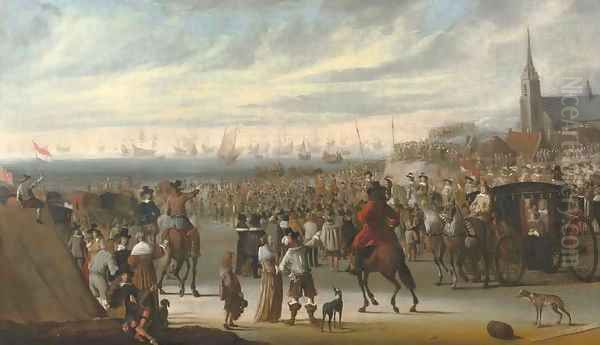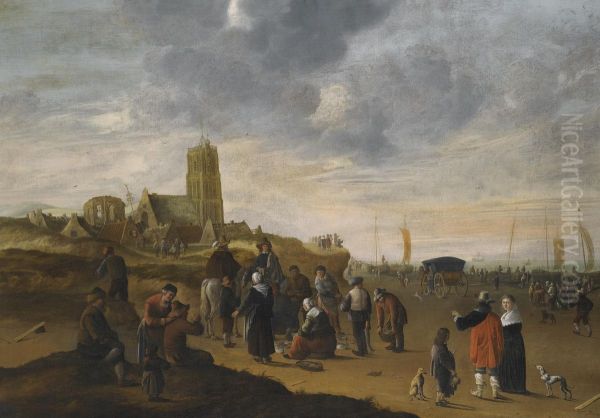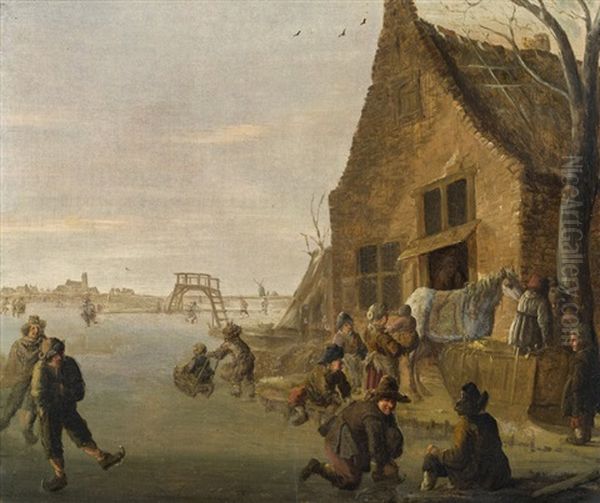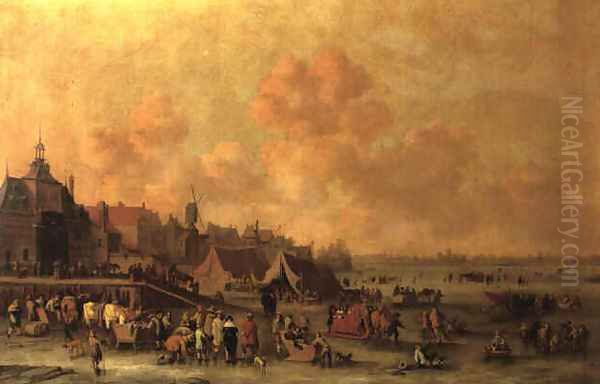Cornelis Beelt stands as a notable figure among the many talented artists of the Dutch Golden Age, a period of extraordinary artistic flourishing in the 17th-century Netherlands. Active primarily in the vibrant artistic center of Haarlem, Beelt specialized in landscape and genre painting, capturing the distinctive atmosphere, daily life, and specific events of his time. While overshadowed by some of the era's giants, his work offers valuable insights into Dutch society and the development of landscape painting, particularly within the Haarlem school. However, reconstructing his life is hampered by uncertainties, particularly regarding his precise birth and death dates.
Biographical Uncertainties and Early Life
The exact biographical details of Cornelis Beelt remain somewhat elusive, a common challenge when studying artists from this period for whom documentation can be sparse. Art historians generally place his birth sometime between 1602 and 1612. The Netherlands Institute for Art History (RKD) suggests this range, although alternative suggestions, such as a birth year around 1640 and origins in Rotterdam, have occasionally surfaced but seem less likely given other evidence.
What seems more certain is his connection to Haarlem. The earliest concrete record places him in this city by 1630. On March 30th of that year, documents record his engagement to marry an unnamed woman. This event firmly establishes his presence in Haarlem during his formative or early mature years as an artist, placing him within one of the most dynamic artistic environments in Europe at the time. His early training remains undocumented, but his style suggests connections to established Haarlem traditions.
Artistic Career and the Haarlem Guild of St. Luke
Cornelis Beelt's documented period of artistic activity spans roughly from the 1630s, or perhaps slightly later, until 1664. He was a productive painter, known for signing his works, which primarily consisted of landscapes, beach scenes, winter scenes, and market squares populated with figures. His activity firmly places him within the heart of the Dutch Golden Age.

Membership in the local Guild of St. Luke was crucial for artists wishing to practice professionally, take on pupils, or sell their work within a city. Beelt became a member of the prestigious Haarlem Guild. His name appears on a list compiled in 1661 featuring 51 painters associated with the Guild who paid annual dues. This inclusion confirms his status as a recognized professional artist within the competitive Haarlem art scene.
The end of Beelt's life presents another biographical puzzle. His last known dated work is from 1664, leading many scholars to believe he died in or shortly after that year. However, complicating this is a later Guild record from 1702 where a "cor: beelt" is marked with a 'd' (presumably for 'dood' or deceased). This has led to speculation that he may have lived much longer, perhaps until 1702. Given the lack of dated works after 1664, the earlier date is often favored for the cessation of his active career, if not his actual death. The discrepancy remains unresolved.
Artistic Style and Influences
Beelt worked firmly within the realist tradition that characterized much of Dutch Golden Age painting. His primary focus was landscape, often infused with genre elements depicting everyday life. His style is generally characterized by relatively fine brushwork, a keen eye for detail, and an ability to capture atmospheric conditions, particularly the cool, silvery light often associated with the Haarlem school of landscape painting.
Art historians note the influence of Willem Gillisz. Kool (c. 1608-1666), another Haarlem painter known for his beach scenes and winter landscapes, on Beelt's work. Both artists shared an interest in depicting the coastal environment near Haarlem, particularly the beach at Scheveningen, often showing fishing boats (pinken) drawn up on the sand and fisherfolk going about their activities. Beelt’s compositions are typically well-structured, often employing diagonal lines to lead the viewer's eye into the scene, and balancing areas of land, water, and sky.
Compared to the more dramatic and emotionally charged landscapes of his Haarlem contemporary Jacob van Ruisdael, Beelt's work often presents a more straightforward, descriptive account of the Dutch environment. He excelled at rendering textures – the roughness of sand dunes, the crispness of ice, the varied fabrics of clothing – adding a tangible quality to his scenes.
Key Themes and Subjects: Chronicling Dutch Life
Cornelis Beelt's oeuvre revolves around several recurring themes, each providing a window into 17th-century Dutch life and landscape.

Winter Landscapes: Like many Dutch artists of his time, Beelt frequently depicted winter scenes. These paintings often feature frozen canals or lakes bustling with activity: skaters gliding across the ice, figures huddled around koek-en-zopie stalls (selling refreshments), children playing, and sleds being pushed. These works capture the social dimension of winter leisure and the characteristic appearance of the Dutch landscape under snow and ice, often under vast, cloud-filled skies. Artists like Hendrick Avercamp and Aert van der Neer pioneered this genre, and Beelt continued the tradition with his own distinct touch.
Coastal and Beach Scenes: Situated near the North Sea coast, Haarlem artists had ready access to maritime subjects. Beelt painted numerous views of the beach, most famously at Scheveningen. These scenes typically depict the wide expanse of sand and sea under changeable skies. Fishing boats, fisherfolk sorting their catch or mending nets, and elegantly dressed figures strolling along the shore are common motifs. These works reflect the importance of the sea and fishing to the Dutch economy and way of life. Philips Wouwerman, another Haarlem master, also frequently painted coastal scenes, though often with a greater emphasis on horses.
Townscapes and Markets: Beelt also turned his attention to urban and village life, painting market squares and town views. These works often function as genre scenes, filled with numerous small figures engaged in buying, selling, conversing, and working. They provide lively snapshots of commerce and social interaction in Dutch towns. These scenes connect his work to the strong tradition of genre painting in Haarlem, practiced by artists such as Adriaen van Ostade and Isaac van Ostade, who focused on peasant life and village festivities.
Historical Events: While primarily a landscape and genre painter, Beelt occasionally depicted specific historical events. His most famous work in this category is The Departure of King Charles II from Scheveningen on the 24 May 1660. This painting commemorates the English king's departure from the Netherlands to reclaim the throne after the Cromwellian period. It is a complex composition filled with numerous figures, ships, and carriages, showcasing Beelt's ability to handle large-scale historical subjects and detailed observation.
Notable Works
While many of Beelt's works are descriptive scenes without specific titles beyond "Winter Landscape" or "Beach Scene," some stand out.

The Departure of King Charles II from Scheveningen on the 24 May 1660: This is arguably Beelt's most historically significant painting. Held by the Maritiem Museum Rotterdam, it captures a moment of international importance. The scene is bustling with activity: dignitaries, soldiers, onlookers, horses, carriages, and numerous ships offshore under a dramatic sky. Beelt meticulously renders the details of costume, transport, and the coastal setting. It demonstrates his skill in marshalling a complex narrative scene and serves as an important visual document of the event.
Skaters on a Frozen Lake at the Edge of Town (and similar winter scenes): Beelt produced many variations on this theme. A typical example might show a wide frozen expanse under a low horizon, emphasizing a large, cloud-laden sky. Numerous small figures animate the scene – elegant couples skating, common folk enjoying themselves, perhaps a distinctive building or windmill anchoring the composition on one side. These works exemplify the Dutch fascination with their winter environment and Beelt's ability to capture its atmosphere and social life. These paintings find parallels in the work of Jan van Goyen and Salomon van Ruysdael, though Beelt often includes more anecdotal detail.
Beach Scene at Scheveningen (and similar coastal views): These paintings often feature the characteristic flat-bottomed fishing boats (pinken) used along the Dutch coast. Beelt depicts the wide, sandy beach, sometimes with dunes in the background, under expansive skies that capture the particular light of the seaside. Figures of fisherfolk provide scale and narrative interest, reflecting the daily toil and maritime character of coastal communities.
Context: The Haarlem School
Cornelis Beelt was an active participant in the Haarlem art scene during its Golden Age peak. Haarlem was a major center for painting, particularly landscape and genre. Beelt worked alongside and in the tradition of several key figures. The early development of realistic landscape painting in Haarlem was pioneered by artists like Esaias van de Velde and Pieter de Molijn.
Beelt's generation included some of the greatest names in Dutch landscape: Jacob van Ruisdael, known for his powerful, often melancholic, natural scenes, and his uncle Salomon van Ruysdael, famed for his tranquil river landscapes with feathery trees and luminous skies. While Beelt's work may not possess the same poetic depth or technical brilliance as Jacob van Ruisdael's, it shares the Haarlem school's interest in realistic depiction and atmospheric effects.

Other notable Haarlem contemporaries included Philips Wouwerman, celebrated for his scenes with horses (battles, hunts, stables, often set in landscapes); the Ostade brothers, Adriaen and Isaac, masters of peasant genre scenes; and the renowned still life painters Pieter Claesz and Willem Claeszoon Heda. Even the great portraitist Frans Hals dominated the Haarlem scene for decades. Although specializing in different genres, the presence of such high-caliber artists created a stimulating, if competitive, environment. Beelt carved out his niche with his accessible and detailed landscapes and town views. Jan Wijnants and Allaert van Everdingen were other significant Haarlem landscape painters active during or overlapping with Beelt's career.
Context: Broader Dutch Golden Age Landscape Painting
Beyond Haarlem, Beelt's work fits into the broader trends of Dutch landscape painting in the 17th century. This era saw landscape evolve from a background element into a major independent genre. Artists across the Netherlands explored different facets of their environment. Jan van Goyen, working mainly in Leiden and The Hague, developed a tonal style emphasizing atmosphere over detail, often using a limited palette. Aelbert Cuyp of Dordrecht became famous for his idyllic river scenes bathed in a warm, golden light, often featuring cattle. Meindert Hobbema, a pupil of Jacob van Ruisdael, specialized in wooded scenes, most famously The Avenue at Middelharnis.
Compared to these artists, Beelt's contribution lies in his consistent production of detailed and lively scenes capturing specific locales and activities, particularly the winter pleasures and coastal life around Haarlem. His work represents the widespread appreciation for realistic depictions of the native landscape and daily life that characterized Dutch art patronage during the Golden Age. He may not have been a major innovator like Rembrandt or Vermeer, but he was a skilled practitioner within his chosen field.
Later Recognition and Legacy
Cornelis Beelt's name was recorded for posterity by Arnold Houbraken, the important early biographer of Dutch artists, in his De groote schouburgh der Nederlantsche konstschilders en schilderessen (The Great Theatre of Dutch Painters and Paintresses, 1718–1721). Inclusion in Houbraken's work helped ensure that Beelt was not entirely forgotten, cementing his place, however modest, in the annals of Dutch art history.
Today, Cornelis Beelt's paintings are held in numerous public collections across the world, including the Rijksmuseum in Amsterdam, the Maritiem Museum Rotterdam, the Frans Hals Museum in Haarlem, and various museums in Germany, the United Kingdom, and the United States. His works appear regularly on the art market, appreciated for their charm, historical detail, and representation of Dutch Golden Age landscape and genre painting.

While perhaps considered a 'minor master' when compared to the towering figures of his time, Cornelis Beelt holds a secure place in art history. He was a competent and prolific painter whose works faithfully reflect the environment and society of 17th-century Holland. His detailed depictions of winter activities, coastal life, and town markets offer enduring visual records of the Dutch Golden Age. His art provides valuable insights into the Haarlem school and the broader development of landscape painting during this remarkably rich period.
Conclusion: A Window onto the Golden Age
Cornelis Beelt navigated the bustling art world of 17th-century Haarlem, contributing his distinct vision to the celebrated tradition of Dutch landscape and genre painting. Despite the frustrating gaps in his biography, his surviving works speak clearly. They depict a world of frozen canals alive with skaters, windswept beaches dotted with fishing boats, and busy market squares reflecting the commerce and community of the Dutch Republic. Through his detailed observations and skilled rendering, Beelt captured the specific character of his time and place. His paintings remain appealing not only for their artistic merit but also as valuable historical documents, offering a glimpse into the landscapes and daily life of the Dutch Golden Age through the eyes of a dedicated Haarlem master.